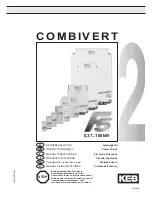
Page 14 of 23
17150 issue 17, October 2018
Vega DC Handbook
Products Covered:
Unit Configuration Code:
a)
V0, K0 or Vega DC
(may be prefixed by NS - # / or - where # may be any characters indicating non-safety related model
differences.
b)
followed by: F, R or C
where F = Standard fan, forward airflow
R = Standard fan, reverse air
C = Customer air
c)
optionally followed by: F, S
where F = Fast-on or quick connect input terminals
S = Screw input terminals
d)
optionally followed by S
where S = Standard filter
e)
optionally followed by: E, F, EV, FV or D
where E = DC input fail with PSU & fan enable and 5V aux supply
F = DC input fail with PSU & fan inhibit and 5V aux supply
EV = DC input fail with PSU & fan enable and 5V/300mA aux supply
FV = DC input fail with PSU & fan inhibit and 5V/300mA aux supply
D = Primary digital option. Provides PSU inhibit and enable, fan monitor, standby supply,
hours of operation, serial numbers, mains fail, over temperature warning. When secondary
digital options fitted also provides status bytes, unit and module IDs, grouping, digital voltage
and current limit programming, secondary inhibit and enable, secondary turn on delay, global
and secondary module good, module monitoring.
Module Configuration Code:
B@, C@, C1Y, D@, E@, F1, F2, H@/@ or H@_@, L@, W2 or W5
where the letter represents a module and @ is a number between 1 and 5, which represents the
number of turns on the transformer secondary. By reference to the following table, this in turn defines
the permitted voltage range of the module.
@ may optionally be followed by the letter L or H, where L and H indicate the low or high output
voltage variants of the module.
For W2 & W5 modules only: @ is followed by F or T, indicating fixed or tracking OVP.
Followed by F or S, where F indicates fast-on output terminals and S indicates screw output
terminals.
or
Z#
where # is a number between 1 and 99. This code represents any two of the above modules that
have had their outputs paralleled together. The number # is a module reference number and does
not represent the number of turns. May optionally followed by F or S, where F indicates fast-on output
terminals and S indicates screw output terminals.
or
BB@, CC@, DD@, EE@, HH@/@ or HH@_@, JJ@/@ or JJ@_@, LL@, C5B4 or B5B4
where @ is a number between 1 and 5, which represents the number of turns on the transformer
secondary. For HH@/@ the code represents one H module that has had its two outputs connected in
series. For all other variants this code represents two modules, selected from those listed above, that
have had their outputs connected in series. May optionally followed by F or S, where F indicates fast-
on output terminals and S indicates screw output terminals.
Note: Seriesed outputs may make all outputs hazardous, see Electrical & Thermal Ratings section
for details. JJ@/@ or JJ@_@, modules are HH@/@ or HH@_@, or modules with reduced OVP
and/or current ratings.









































